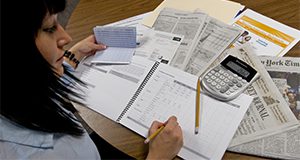Risk identification is the beginning point for risk management planning because solution identification begins with knowledge of the problem. This 4-page document presents questions to consider regarding production risk, price or market risk, financial risk, legal risk, and human risk. Written by Martie Gillen and Beatrice Pierre, and published by the UF/IFAS Department of Family, Youth and Community Sciences, August 2019.
http://edis.ifas.ufl.edu/fy1485
Tag: Martie Gillen
Strategies to Fund Your Child’s College Education: Using Savings and Tax-Advantaged Vehicles
It is never too soon to explore funding options for college educations, whether your child is a newborn or is in middle school. You are more likely to be prepared to fund your child's education if you start planning earlier. This new 4-page document describes and discusses several accounts that allow you to pay for college while taking advantage of tax and savings opportunities. Written by Jessica McCumber, Jorge Ruiz-Menjivar, Martie Gillen, and Sarah M. Ellis, and published by the UF/IFAS Department of Family, Youth and Community Sciences, June 2019.
http://edis.ifas.ufl.edu/fy1484
An Overview of Risk Management Planning
As risks evolve and diversify, approaches to conducting business require a targeted focus on risk management, particularly in agriculture. This new 3-page document explores risk in agriculture, the need to understand risk, formation of strategies to manage risk, and government programs that exist to help growers and producers manage risk. Written by Martie Gillen and Beatrice Pierre, and published by the UF/IFAS Department of Family, Youth and Community Sciences, May 2019.
http://edis.ifas.ufl.edu/fy1482
Major Asset Classes: A Brief Glossary
The best time to have started investing is yesterday. This new 2-page document aims to provide a brief but comprehensive glossary of the main financial investment vehicles. Written by Jarrett Tsai, Jorge Ruiz-Menjivar, and Martie Gillen, and published by the UF/IFAS Department of Family, Youth and Community Sciences, May 2019.
http://edis.ifas.ufl.edu/fy1483
Elder Nutrition
Older Floridians, their families, and communities face many issues related to aging. This 8-page fact sheet focuses on the way aging affects nutrition and diet, and choices that older adults can make to improve or maintain their health and well-being as they age. Written by Linda B. Bobroff and Martie Gillen, and published by the UF/IFAS Department of Family, Youth and Community Sciences, revised March 2018.
http://edis.ifas.ufl.edu/fy628
Elder Nutrition
 Good nutrition is important throughout life, starting even before we are born. However, at certain stages in life, such as infancy, pregnancy, and in older age, the importance of having good eating habits is especially critical. This 8-page fact sheet focuses on how aging affects nutrition and diet and choices that older adults can make to improve or maintain their health and well-being as they age.was written by Linda B. Bobroff and Martie Gillen, and published by the UF Department of Family Youth and Community Sciences, April 2014.
Good nutrition is important throughout life, starting even before we are born. However, at certain stages in life, such as infancy, pregnancy, and in older age, the importance of having good eating habits is especially critical. This 8-page fact sheet focuses on how aging affects nutrition and diet and choices that older adults can make to improve or maintain their health and well-being as they age.was written by Linda B. Bobroff and Martie Gillen, and published by the UF Department of Family Youth and Community Sciences, April 2014.
http://edis.ifas.ufl.edu/fy628
Understanding the Changes to the Patient’s Bill of Rights as a Result of the Affordable Care Act
 The Affordable Care Act is a legislative act that has provided individuals and families more choices related to healthcare insurances. It offers consumers new protections and benefits by creating a more defined Patient’s Bill of Rights. This 2-page fact sheet was written by Deanna Andrews and Martie Gillen, and published by the UF Department of Family Youth and Community Sciences, May 2014.
The Affordable Care Act is a legislative act that has provided individuals and families more choices related to healthcare insurances. It offers consumers new protections and benefits by creating a more defined Patient’s Bill of Rights. This 2-page fact sheet was written by Deanna Andrews and Martie Gillen, and published by the UF Department of Family Youth and Community Sciences, May 2014.
http://edis.ifas.ufl.edu/fy1410
Important Things to Know about Medicare series
 As an older adult citizen of the United States, it is important to understand the structure of Medicare and how it affects you. The information in this series is based on the most current data available and includes several changes with the implementation of the Affordable Care Act. This guide was also written using Florida guidelines when appropriate. Please bear in mind that your personal situation may vary from the examples in the series, and always contact your local Medicare representative for questions regarding your own circumstances.
As an older adult citizen of the United States, it is important to understand the structure of Medicare and how it affects you. The information in this series is based on the most current data available and includes several changes with the implementation of the Affordable Care Act. This guide was also written using Florida guidelines when appropriate. Please bear in mind that your personal situation may vary from the examples in the series, and always contact your local Medicare representative for questions regarding your own circumstances.
- Introduction and Overview
- Chapter One–Who Is Eligible for Medicare, and Do I Have To Sign Up for It?
- Chapter Two: Medicare Part A–Hospital Insurance
- Chapter Three: Medicare Part B–Medical Insurance
- Chapter Four–Medicare Part C – Medicare Advantage
- Chapter Five–Medicare Part D–Prescription Drug Coverage
- Chapter Six–“Medigap” Policies
- Chapter Seven–How does my other insurance work with Medicare? Who pays first?
- Chapter Eight–What if I need help paying my health care and prescription drug costs?
- Chapter Nine–How should I decide how I want to get my Medicare?
- Chapter Ten–Key Terms, Additional Resources, List of Handouts, and References
Written by Amanda Terminello and Martie Gillen, and published by the UF Department of Family Youth and Community Sciences, September 2013.
http://edis.ifas.ufl.edu/topic_series_important_things_to_know_about_medicare
The Facts About Applying: Health Care Coverage and the Affordable Care Act
 President Obama signed the Affordable Care Act into law in March 2010, putting in place a set of reforms to health coverage in the United States. For Americans who have health insurance, they do not have to change their current plan under the health care law. However, those who do not have coverage will have the chance to shop for health insurance starting October 1 using the new Health Insurance Marketplace. This publication reviews some common questions about the new health care law and how it will affect citizens. This 3-page fact sheet was written by Meg McAlpine and Martie Gillen, and published by the UF Department of Family Youth and Community Sciences, October 2013.
President Obama signed the Affordable Care Act into law in March 2010, putting in place a set of reforms to health coverage in the United States. For Americans who have health insurance, they do not have to change their current plan under the health care law. However, those who do not have coverage will have the chance to shop for health insurance starting October 1 using the new Health Insurance Marketplace. This publication reviews some common questions about the new health care law and how it will affect citizens. This 3-page fact sheet was written by Meg McAlpine and Martie Gillen, and published by the UF Department of Family Youth and Community Sciences, October 2013.
http://edis.ifas.ufl.edu/fy1394
An Overview of Life Insurance
 The primary purpose for buying life insurance is to protect the people who depend on you. A life insurance policy can help to ensure your family’s financial needs are met even after your untimely death. Life insurance can also provide a way to leave a cash gift to your spouse, children, grandchildren, or charities. Once you decide to buy a life insurance policy, you will have a few decisions to make. You will need to select among the different types of life insurance, decide on a dollar amount, and name your beneficiaries. In this publication, you will learn about the different types of life insurance and the ways to determine the amount of life insurance you may need. This 4-page fact sheet was written by Lisa Leslie and Martie Gillen, and published by the UF Department of Family Youth and Community Sciences, October 2013.
The primary purpose for buying life insurance is to protect the people who depend on you. A life insurance policy can help to ensure your family’s financial needs are met even after your untimely death. Life insurance can also provide a way to leave a cash gift to your spouse, children, grandchildren, or charities. Once you decide to buy a life insurance policy, you will have a few decisions to make. You will need to select among the different types of life insurance, decide on a dollar amount, and name your beneficiaries. In this publication, you will learn about the different types of life insurance and the ways to determine the amount of life insurance you may need. This 4-page fact sheet was written by Lisa Leslie and Martie Gillen, and published by the UF Department of Family Youth and Community Sciences, October 2013.
http://edis.ifas.ufl.edu/fy1393
Women and Money: Unique Issues – Selecting Your Financial Professional Team
 On your road to building wealth, you may choose to engage financial professionals for guidance. Seeking out professional advice will include fees and expenses, so use care when selecting the appropriate services. There is a variety of financial professionals to choose from, including financial planners, investment specialists, accountants, attorneys, insurance agents, and bankers. Understanding the roles, expertise, and credentials of these individuals can help you select the most appropriate individual or team for your specific financial needs.
On your road to building wealth, you may choose to engage financial professionals for guidance. Seeking out professional advice will include fees and expenses, so use care when selecting the appropriate services. There is a variety of financial professionals to choose from, including financial planners, investment specialists, accountants, attorneys, insurance agents, and bankers. Understanding the roles, expertise, and credentials of these individuals can help you select the most appropriate individual or team for your specific financial needs.
This 4-page fact sheet was written by Brenda C. Williams, Diann Douglas, Martie Gillen, and Lynda Spence, and published by the UF Department of Family Youth and Community Sciences, July 2013.
http://edis.ifas.ufl.edu/fy1370
Women and Money: Unique Issues: Your Money Matters
 Couples considering a future together should discuss money before they marry. Discussing money may not be the most romantic gesture, but this is an important conversation to have early in a relationship and to continue to have throughout your marriage.This 4-page fact sheet was written by Diann Douglas and Martie Gillen, and published by the UF Department of Family Youth and Community Sciences, September 2013.
Couples considering a future together should discuss money before they marry. Discussing money may not be the most romantic gesture, but this is an important conversation to have early in a relationship and to continue to have throughout your marriage.This 4-page fact sheet was written by Diann Douglas and Martie Gillen, and published by the UF Department of Family Youth and Community Sciences, September 2013.
http://edis.ifas.ufl.edu/fy046
Women and Money: Unique Issues: Protecting Your Assets
 Protecting your assets is similar to managing your risks. Managing risks means identifying and evaluating instances where you may experience a financial loss and then making a plan for how to deal with the situation. This publication shares some common ways you can protect your assets by purchasing different types of insurance, being aware of identity theft or fraud, and monitoring your credit reports. This 4-page fact sheet was written by Lynda Spence, Martie Gillen, and Diann Douglas, and published by the UF Department of Family Youth and Community Sciences, July 2013.
Protecting your assets is similar to managing your risks. Managing risks means identifying and evaluating instances where you may experience a financial loss and then making a plan for how to deal with the situation. This publication shares some common ways you can protect your assets by purchasing different types of insurance, being aware of identity theft or fraud, and monitoring your credit reports. This 4-page fact sheet was written by Lynda Spence, Martie Gillen, and Diann Douglas, and published by the UF Department of Family Youth and Community Sciences, July 2013.
http://edis.ifas.ufl.edu/fy1375
Benefits of Family Meals (FCS2324/FY1362)
 Over the past 30 years obesity among children has increased. One way to help youth make healthy food choices is by creating healthy eating choices and habits at home, starting with family meals. When parents value family dinners, children are likely to view family dinners as important. Family meals can provide important examples to show children what foods are good to eat and how much of the good foods they should eat. This 5-page fact sheet was written by Varnessa McCray, Victor W. Harris, and Martie Gillen, and published by the UF Department of Family Youth and Community Sciences, April 2013.
Over the past 30 years obesity among children has increased. One way to help youth make healthy food choices is by creating healthy eating choices and habits at home, starting with family meals. When parents value family dinners, children are likely to view family dinners as important. Family meals can provide important examples to show children what foods are good to eat and how much of the good foods they should eat. This 5-page fact sheet was written by Varnessa McCray, Victor W. Harris, and Martie Gillen, and published by the UF Department of Family Youth and Community Sciences, April 2013.
http://edis.ifas.ufl.edu/fy1362
Family Records (FCS7103/HE988)
 This publication should be kept in a safe place known to adult members of your family and/or trusted friend(s). An additional copy should be kept in a safe deposit box. Revise it annually or after any life-changing circumstance to keep vital information current. This can make looking for vital records much faster and easier. It can also be used as a starting place for estate planning. These checklists provide suggestions on where to keep your important papers and what information to keep. This 14-page fact sheet was written by Brenda C. Williams, Brittany Seamon, and Martie Gillen, and published by the UF Department of Family Youth and Community Sciences, April 2013.
This publication should be kept in a safe place known to adult members of your family and/or trusted friend(s). An additional copy should be kept in a safe deposit box. Revise it annually or after any life-changing circumstance to keep vital information current. This can make looking for vital records much faster and easier. It can also be used as a starting place for estate planning. These checklists provide suggestions on where to keep your important papers and what information to keep. This 14-page fact sheet was written by Brenda C. Williams, Brittany Seamon, and Martie Gillen, and published by the UF Department of Family Youth and Community Sciences, April 2013.
http://edis.ifas.ufl.edu/he988
My Child Has a Mental Illness: Developing Parental Advocacy Skills (FCS2327/FY1365)
 If your child is diagnosed with a mental illness, you will face major changes in your life. Being proactive about your child’s care and advocating for him or her will help you and your child handle the illness successfully. This 5-page fact sheet was written by Tracy DeCubellis, Victor W. Harris, and Martie Gillen, and published by the UF Department of Family Youth and Community Sciences, April 2013.
If your child is diagnosed with a mental illness, you will face major changes in your life. Being proactive about your child’s care and advocating for him or her will help you and your child handle the illness successfully. This 5-page fact sheet was written by Tracy DeCubellis, Victor W. Harris, and Martie Gillen, and published by the UF Department of Family Youth and Community Sciences, April 2013.
http://edis.ifas.ufl.edu/fy1365
Promoting Healthy Relationship Development in Teens, Part I: How Dating Smart in Youth Can Foster Better Relationships in Adulthood (FCS2325/FY1363)
 Cultivating healthy dating relationships that can lead to healthy adult romantic and marriage relationships is a science that reflects a complicated calculus of the premarital influences that may shape future relationship stability, quality, and satisfaction. This 4-page fact sheet was written by Victor W. Harris, Gilon Marts, and Martie Gillen, and published by the UF Department of Family Youth and Community Sciences, March 2013.
Cultivating healthy dating relationships that can lead to healthy adult romantic and marriage relationships is a science that reflects a complicated calculus of the premarital influences that may shape future relationship stability, quality, and satisfaction. This 4-page fact sheet was written by Victor W. Harris, Gilon Marts, and Martie Gillen, and published by the UF Department of Family Youth and Community Sciences, March 2013.
http://edis.ifas.ufl.edu/fy1363
Women and Money: Unique Issues: Money and the Family (FCS7250/FY1354)
 Ask any parent and he or she will tell you — it costs money to raise children. Taking into account inflation, a middle-income family may spend more than $295,000 to raise a child born in 2011 to the age of 17. This is not a small amount of money, so you will need to know the types of expenses required to raise your family. This 5-page fact sheet reviews the costs associated with raising children and gives you tips on how to teach your children about finances. By knowing the costs of raising your family and setting up a budget, you can teach your children money management skills that will help them throughout their lives. Written by Lynda Spence, Martie Gillen, and Diann Douglas, and published by the UF Department of Family Youth and Community Sciences, March 2013.
Ask any parent and he or she will tell you — it costs money to raise children. Taking into account inflation, a middle-income family may spend more than $295,000 to raise a child born in 2011 to the age of 17. This is not a small amount of money, so you will need to know the types of expenses required to raise your family. This 5-page fact sheet reviews the costs associated with raising children and gives you tips on how to teach your children about finances. By knowing the costs of raising your family and setting up a budget, you can teach your children money management skills that will help them throughout their lives. Written by Lynda Spence, Martie Gillen, and Diann Douglas, and published by the UF Department of Family Youth and Community Sciences, March 2013.
http://edis.ifas.ufl.edu/fy1354
Women and Money: Unique Issues: Money Issues across the Life Cycle (FCS7248/FY1352)
 Most families depend on a woman’s income to help support the household. Some women are co-breadwinners while others are the only source of income. Throughout a woman’s life, she will experience many money issues unique to women. A woman may experience the following situations: lower earnings, a longer life expectancy, lack of retirement planning, divorce, and fewer years in the workplace because of childrearing or caring for older parents. Many of these issues can work against a woman’s ability to accumulate money and attain stable financial status. This 3-page fact sheet was written by Diann Douglas, Martie Gillen, and Lynda Spence, and published by the UF Department of Family Youth and Community Sciences, March 2013.
Most families depend on a woman’s income to help support the household. Some women are co-breadwinners while others are the only source of income. Throughout a woman’s life, she will experience many money issues unique to women. A woman may experience the following situations: lower earnings, a longer life expectancy, lack of retirement planning, divorce, and fewer years in the workplace because of childrearing or caring for older parents. Many of these issues can work against a woman’s ability to accumulate money and attain stable financial status. This 3-page fact sheet was written by Diann Douglas, Martie Gillen, and Lynda Spence, and published by the UF Department of Family Youth and Community Sciences, March 2013.
http://edis.ifas.ufl.edu/fy1352
Retirement Need Analysis: How Much of My Current Income Will I Need for Retirement? (FCS7251/FY1355)
 The amount of money needed for retirement varies from person to person. There may not be an exact amount, but there are ways to estimate the amount you will need. While no “magic number” exists for the amount you should save for retirement, there are calculations you can use to estimate the amount you will need. Calculating your wage replacement ratio (WRR) using either the top-down or bottom-up approach can help you determine how much money you should put aside for retirement and provide you with savings goals. This 3-page fact sheet was written by Jorge Ruiz-Menjivar and Martie Gillen, and published by the UF Department of Family Youth and Community Sciences, March 2013.
The amount of money needed for retirement varies from person to person. There may not be an exact amount, but there are ways to estimate the amount you will need. While no “magic number” exists for the amount you should save for retirement, there are calculations you can use to estimate the amount you will need. Calculating your wage replacement ratio (WRR) using either the top-down or bottom-up approach can help you determine how much money you should put aside for retirement and provide you with savings goals. This 3-page fact sheet was written by Jorge Ruiz-Menjivar and Martie Gillen, and published by the UF Department of Family Youth and Community Sciences, March 2013.
http://edis.ifas.ufl.edu/fy1355



